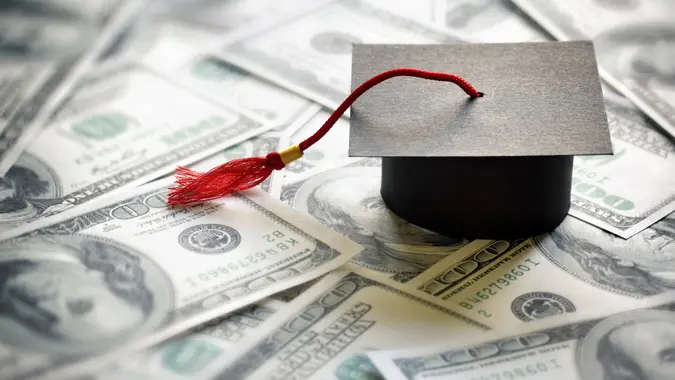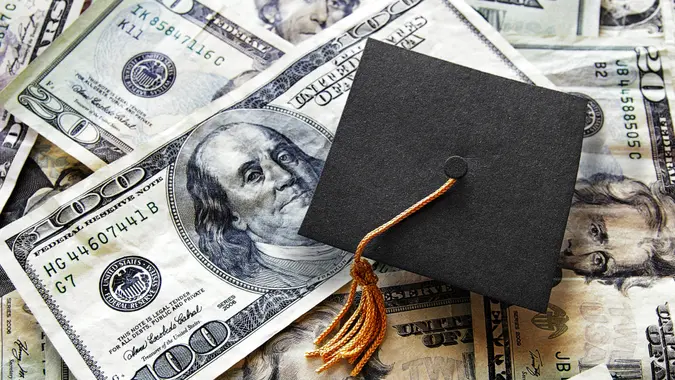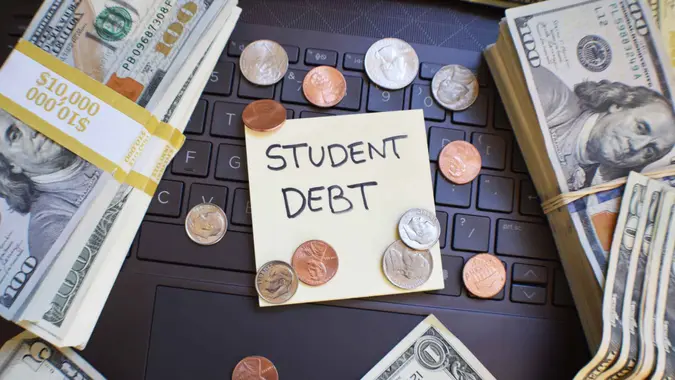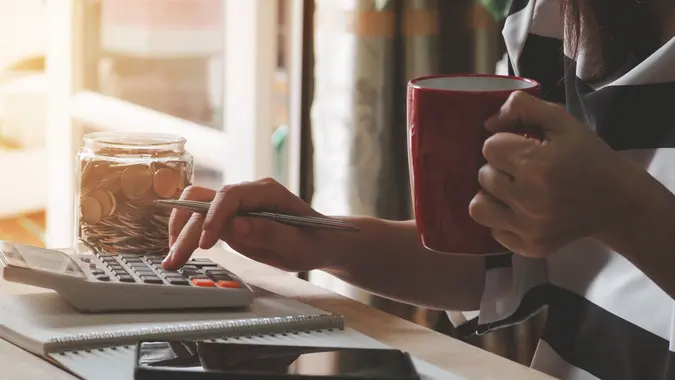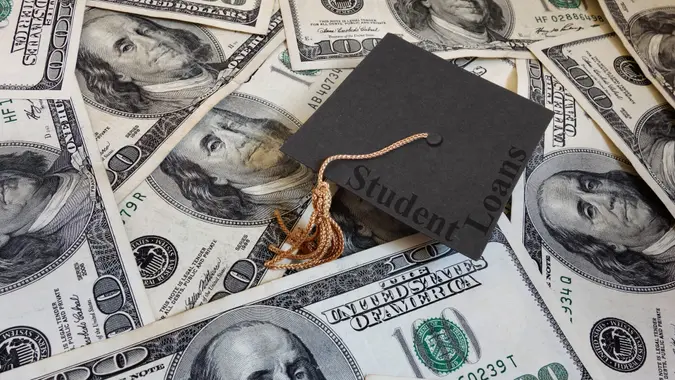Student Loan in Default? Here’s How You Can Fix It

Commitment to Our Readers
GOBankingRates' editorial team is committed to bringing you unbiased reviews and information. We use data-driven methodologies to evaluate financial products and services - our reviews and ratings are not influenced by advertisers. You can read more about our editorial guidelines and our products and services review methodology.

20 Years
Helping You Live Richer

Reviewed
by Experts

Trusted by
Millions of Readers
Defaulting on your student loans can put you in a sticky financial situation. While no one wants to default, it’s a possibility if you don’t pay back your student loans according to the agreed-upon terms. If you find your student loans in default, you can take action to minimize the damage done. Keep reading to learn more.
4 Ways To Recover From Federal Student Loan Default
The federal government provides significant borrower protections to help former students avoid default. But after 270 days of non-payment, your student loans will go into default. The good news is that as a federal student loan borrower, you have access to more ways to fix a defaulted loan.
Below are some strategies to help you recover from student loan default.
1. Fresh Start Program
Fresh Start is a new program that became available to federal student loan borrowers earlier this year. It’s a one-time opportunity for student loan borrowers to pull their loans out of default. You can sign up for the program by contacting the Department of Education’s Default Resolution Group.
If you qualify, the program will restore your access to loan rehabilitation options. They will also switch the reporting from “in default” to “in repayment.” Additionally, you’ll have access to federal student loan income-driven repayment plans. This can help you lock in an affordable monthly payment that works for your budget.
2. Student Loan Rehabilitation
The federal government offers student loan borrowers Direct and FFEL loans to rehabilitate their loans. Through the program, you must agree to make nine affordable monthly payments for ten consecutive months voluntarily. The payments must be made within 20 days of the due date.
While you will voluntarily agree to the payments, your loan servicer will determine the monthly payment amount. The factors taken into account when determining your monthly payment include your discretionary income, gross income and poverty level for your location. You’ll generally be expected to pay 15% of your annual discretionary income over the course of 12 even monthly payments.
Good To Know
According to the Department of Education, the required monthly payment during loan rehabilitation could be as low as $5. If you keep up your end of the bargain with consistent monthly payments, the loan is taken out of default.
From there, you’ll be eligible for all federal student loan benefits and escape any wage garnishment stressors. Importantly, the history of late payments during your default will remain on your credit report, which can lead to lasting negative impacts on your credit score.
3. Federal Student Loan Consolidation
Consolidating your federal student loans offers another pathway to get out of student loan default. With a Direct Consolidation Loan, you’ll pay off one or more federal student loans to replace them with a single loan. With the new loan, you can sign up for an income-driven repayment plan that better suits your financial situation.
In order to consolidate a defaulted federal student loan, you’ll need to agree to a new IDR plan or make three voluntary, consecutive monthly payments on the defaulted loan before you can consolidate it. If you choose the monthly payment route, you must make full monthly payments for three months in a row. And the payments must be on-time.
4. Pay Off the Loan
While paying off the loan in full isn’t a feasible option for many borrowers, it’s another way to pull your loans out of default. Not only will the loans be out of default status, but you can eliminate the debt from your books entirely.
A few ways to pursue this strategy might include breaking into a certificate of deposit or draining your emergency fund. But for most borrowers, the options presented earlier on this list are more achievable.
How To Recover From Private Student Loan Default
Private student loan lenders each have their own rules surrounding default. However, most private lenders consider student loans to be in default after 90 days of non-payment. If you have a private student loan in default, you have more limited options than federal student loan borrowers.
In general, the best course of action is to get in touch with your lender. If possible, reach out to your lender before you miss a payment. As soon as you spot a potential payment issue, contact your lender to find out if they offer any relief. In some cases, the lender will be able to offer a deferment or other reprieve to help you avoid default.
How To Avoid Student Loan Default
While it might be possible to pull your student loans out of default, it’s easier to manage your student loans if they don’t fall into default. As a student loan borrower, here are some ways to avoid this bad situation:
- Read your loan terms: The first step to avoiding student loan default is to understand the rules. You can avoid making a mistake by reading through the details of your repayment terms closely.
- Stay in touch with your lender: Misdirected information can have serious consequences. If you move or change your email address, let your loan servicer know right away. Otherwise, you might not get the information you need to make on-time payments or find out about an issue with your payments until it’s too late.
- Keep detailed records: Straightforward record-keeping can help you stay on top of your loans. Try to keep all of your loan repayment information in a single location.
Final Take
Defaulting on your student loans can have a significantly negative impact on your financial situation. Luckily, it’s sometimes possible to restore your student loans from default. Although the process isn’t always easy, taking advantage of the opportunities to get your loan back on track can be worth it. If your student loans are in default, move forward with the option that works best for your situation today.
FAQ
- What happens if you default on a student loan?
- If you default on your student loans, it can have a negative impact on your credit score. For federal student loan borrowers, you'll also lose access to some federal student loan programs.
- What is student loan default?
- Student loan default happens when you don't repay the loan according to the agreed-upon terms. For federal student loans, default happens when you haven't made a payment to your federal student loans in 270 days.
- Will student loans be forgiven if in default?
- Defaulted federal student loans aren't eligible for any forgiveness programs.
- Will defaulted student loans be offset in 2023?
- In general, the government will take any tax return owed to you to cover the defaulted balance. But for the 2023 tax season, your tax return won't be used to offset a defaulted federal student loan balance.
Information is accurate as of July 13, 2023.
Our in-house research team and on-site financial experts work together to create content that’s accurate, impartial, and up to date. We fact-check every single statistic, quote and fact using trusted primary resources to make sure the information we provide is correct. You can learn more about GOBankingRates’ processes and standards in our editorial policy.
- Federal Student Aid. "Get Out of Default With Fresh Start."
- Federal Student Aid. "Don’t get discouraged if you’re in default on your federal student loan."
- Federal Student Aid. "Student Loan Delinquency and Default."
 Written by
Written by  Edited by
Edited by 



